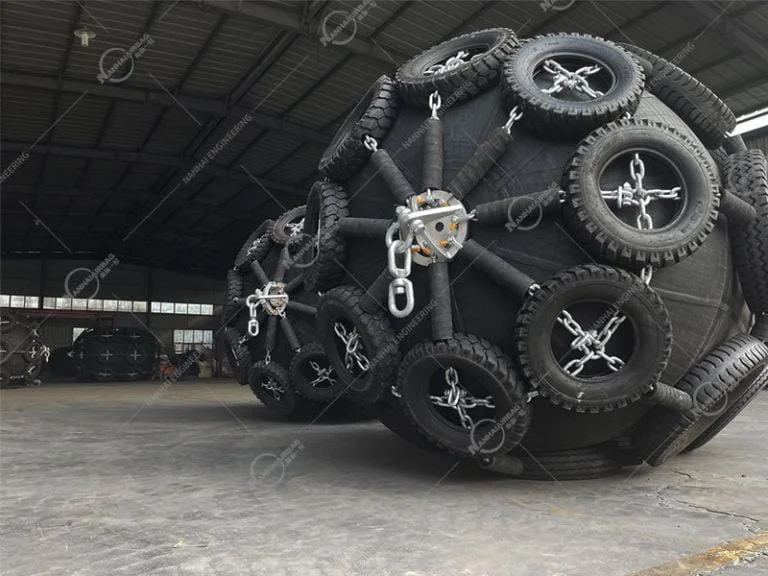Required Ship Parameters When Using Marine Airbags
06/20/2025The impact of smart ports on marine fenders
06/23/2025Why Pneumatic Fenders Lead in Ship Protection
Imagine two massive vessels, each carrying millions of dollars in cargo, approaching a busy port. Even a minor miscalculation could lead to catastrophic damage, environmental disaster, and huge financial losses. This isn’t a rare occurrence; with increasing global trade, our waterways are becoming more crowded than ever. So, how does the maritime industry address this vital safety concern? The answer, for many, lies in the widespread adoption of pneumatic fenders.
What are pneumatic fenders?
Pneumatic fenders, also known as Yokohama fenders, offer superior energy absorption capabilities compared to traditional solid fenders. Their air-filled construction allows them to compress and deform under impact, effectively dissipating kinetic energy and minimizing the forces exerted on both vessels.
The inherent flexibility and low reaction force of pneumatic fenders make them ideal for a wide range of ship-to-ship (STS) transfers and ship-to-dock (STD) operations, accommodating various vessel sizes and hull shapes without causing excessive stress.
Ease of installation, portability, and relatively low maintenance requirements contribute significantly to the cost-effectiveness and operational efficiency of pneumatic fender systems, making them a preferred choice for many maritime stakeholders.
But what exactly makes these inflatable marvels so much better than the rigid bumpers of yesteryear? And how are they changing the game for safer marine operations around the globe? Let’s dive deeper into the engineering brilliance and practical advantages that have solidified the pneumatic fender’s reputation as a leader in maritime safety.

With the increasing size of transport vessels, the focus on maritime berthing safety has reached new heights. The previously used compression-type rubber fenders could no longer meet the demands for high impact energy absorption, leading to the emergence of pneumatic fenders.
Pneumatic fenders utilize compressed air as a buffer medium. When a ship impacts and compresses them, they deform softly, not only absorbing a large amount of energy but also applying a very uniform reaction force to the ship, without damaging the hull or its coating. Therefore, they offer significant advantages over traditional rubber fenders that rely solely on compressive elasticity.
Key Advantages of Pneumatic Fenders:
1. High Energy Absorption
The amount of absorbed energy is a primary technical performance indicator for fendering equipment. As ship tonnage increases, the impact energy during berthing operations, whether with a dock or other vessels, multiplies. This immense impact energy must be absorbed through sufficient deformation and a large enough contact area provided by the fender. Pneumatic fenders can achieve a compression deformation of over 60%, and their contact area rapidly expands with deformation, making their energy absorption capacity far greater than other types of fenders.
2. Ultra-Low Reaction Force
Pneumatic fenders are filled with low-pressure gas, and the increase in internal pressure during compression deformation is very limited. Due to the large contact area, the unit pressure exerted on the ship’s hull surface is extremely low, only 120 kN per square meter. Compared to other fendering equipment, this is an exceptionally low reaction force.
3. Excellent Adaptability to Angled Contact
For vessels, there is always a possibility of approaching a dock or another ship at an angle. Pneumatic fenders demonstrate much higher adaptability to angled contact compared to other types of fenders.
4. Floats on Water, Suitable for Ship Motion
Pneumatic fenders float on the water, meaning their position relative to the ship’s side remains unchanged with the rise and fall of the tide. Especially when a ship sways with the waves, the cylindrical pneumatic fender rolls along with it, resulting in very low friction. This not only prevents damage to the ship’s surface coating but also helps reduce rolling and vibration.
FAQ:
What are the main benefits of using pneumatic fenders?
They absorb high-impact energy, exert very low force on ships, adapt well to different angles, and float to adjust with ship and tide movements.
How do Yokohama fenders protect ships during transfers?
They act as a cushion, absorbing impact energy and spreading the force over a large area, preventing damage to both ship hulls during transfers.
Are pneumatic fenders better than foam fenders?
For high energy absorption and very low reaction forces, pneumatic fenders are generally more effective due to their greater compression and larger contact area.
How long do pneumatic ship fenders last?
With good maintenance and quality materials, they can last 10-15 years or more, but it depends on usage and conditions.
